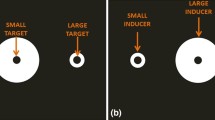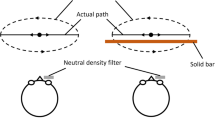Abstract
The interactions between illusory and real contours have been investigated under monocular, binocular and dichoptic conditions. Results show that under all three presentation conditions, periodic alternations, generally called rivalry, occur during the perception of cognitive (or illusory) triangles, while earlier research had failed to find such rivalry (Bradley and Dumais 1975). With line triangles, rivalry is experienced only under dichoptic conditions. A model is proposed to account for the observed phenomena.
Similar content being viewed by others
References
Aulhorn E (1966) Phasendifferenz-Haploskopie. Eine neue Methode zur Trennung der Seheindrücke beider Augen. Klin Monatbl Augenheilkd 148:540–544
Barlow HB (1972) Single units and sensation: a neuron doctrine for perceptual psychology? Perception 1:371–394
Beckett PA (1989) Illusion decrement and transfer of illusion decrement in real- and subjective-contour Poggendorff figures. Percept Psychophys 45:550–556
Benham CE (1894) Artificial spectrum top. Nature 51:113–114
Blake R (1989) A neural theory of binocular rivalry. Psychol Rev 96:145–167
Blake R, Overton R (1979) The site of binocular rivalry suppression. Perception 8:143–152
Bradley DR (1982) Binocular rivalry of real vs. subjective contours. Percept Psychophys 32:85–87
Bradley DR, Dumais ST (1975) Ambiguous cognitive contours. Nature 257:582–584
Bravo M, Blake R, Morrison S (1988) Cats see subjective contours. Vision Res 28:861–865
Breese BB (1909) Binocular rivalry. Psychol Rev 16:410–415
Cavanagh P (1987) Reconstructing the third dimension: Interactions between colour, texture, motion, binocular disparity, and shape. Comput Vision Graph Image Proc 37:171–195
Edelman S, Weinshall D (1991) Computational vision. A critical review. In: Watt R (ed) Pattern recognition by man and machine, vol 14: Vision and visual dysfunction, Macmillan, London
Fahle M (1982) Binocular rivalry: suppression depends on orientation and spatial frequency. Vision Res 22:787–800
Fahle M (1987) The apparent size of objects situated in front of or behind the horopter. Graefe's Arch Clin Exp Ophthalmol 225:39–44
Gilbert CD (1988) Neuronal and synaptic organization in cortex. In: Rakic P, Singer W (eds) Group report Neurobiology of neocortex. Wiley, New York, pp 219–241
Gray CM, König P, Engel AK, Singer W (1989) Oscillatory responses in cat visual cortex exhibit inter-columnar synchronization which reflects global stimulus properties. Nature 338:334–337
Gregory RL, Harris JP (1974) Illusory contours and stereo depth. Percept Psychophys 15:411–416
Grossberg S (1987) Cortical dynamics of three-dimensional form, color and brightness perception: 2. Binocular theory. Percept Psychophys 41:117–158
Harris JP, Gregory RL (1973) Fusion and rivalry of illusory contours. Perception 2:235–247
Hermann L (1870) Eine Erscheinung simultanen Kontrastes. Pfluegers Arch Ges Physiol 3:13–15
Julesz B (1971) Foundations of cyclopean perception. University of Chicago Press, Chicago
Kanizsa G (1955) Margini quasi-percettivi in campi con stimolazione omogenea. Riv Psicol 49:7–30
Lawson RB, Gulick WL (1967) Stereopsis and anomalous contour. Vision Res 7:271–297
Lawson RB, Cowan E, Gibbs TD, Whitmore, CG (1974) Stereoscopic enhancement and erasure of subjective contours. J Exp Psychol 103:1142–1146
Lehky SR (1988) An astable multivibrator model of binocular rivalry. Perception 17:215–228
Logothetis NK, Schall JD (1989) Neuronal correlates of subjective visual perception. Science 245:761–763
Marr D (1982) Vision. Freeman, San Francisco
Mather G (1989) The role of subjective contours in capture of stereopsis. Vision Res 29:143–146 (1989)
Paradiso MA, Shimojo S, Nakayama K (1989) Subjective contours, tilt aftereffect, and visual cortical organization. Vision Res 29:1205–1213
Parks TE (1984) Illusory figures: a (mostly) atheoretical review. Psychol Bull 95:282–300
Petersik TJ, Hicks Kl, Pantle AJ (1978) Apparent movement of successively generated subjective figures. Perception 7:371–383
Poggio T, Torre V, Koch C (1985) Computational vision and regularization theory. Nature 317:314–319
Ramachandran VS, Cavanagh P (1985) Subjective contours capture stereopsis. Nature 317:527–530
Redies C, Crook JM, Creutzfeldt OD (1986) Neuronal responses to borders with and without luminance gradients in cat visual cortex and dorsal lateral geniculate nucleus. Exp Brain Res 61:469–481
Schuhmann F (1904) Einige Beobachtungen über die Zusammenfassung von Gesichtseindrücken zu Einheiten. Psychol Stud 1:1–32
Sloane ME (1985) Binocular rivalry: a psychophysics in search of a physiology. In: Rose D, Dobson Vg (eds) Models of visual cortex. Wiley, Chichester pp 211–222
Smith A, Over R (1975) Tilt aftereffects with subjective contours. Nature 257:581–582
Ullman S (1976) Filling in the gaps: the shape of subjective contours and a model for their generation. Biol Cybern 25:1–6
Ullman S (1989) Aligning pictorial descriptions: an approach to object recognition. Cognition 32:193–254
Von der Heydt R, Peterhans E, Baumgartner G (1984) Illusory contours and cortical neuron responses. Science 224:1260–1262
Von der Heydt R, Peterhans E, Baumgartner G (1990) Neuronal processing of contours. NIPS 5:152–155
Walker JT, Shank MD (1988) Interactions between real and subjective contours in the Bourdon illusion. Percept Psychophys 43:567–574
Whitmore CLG, Lawson RB, Kozora CE (1976) Subjective contours in stereoscopic space. Percept Psychophys 19:211–213
Wolfe JM (1986) Stereopsis and binocular rivalry. Psychol Rev 93:269–282
Author information
Authors and Affiliations
Rights and permissions
About this article
Cite this article
Fahle, M., Palm, G. Perceptual rivalry between illusory and real contours. Biol. Cybern. 66, 1–8 (1991). https://doi.org/10.1007/BF00196447
Received:
Accepted:
Issue Date:
DOI: https://doi.org/10.1007/BF00196447




